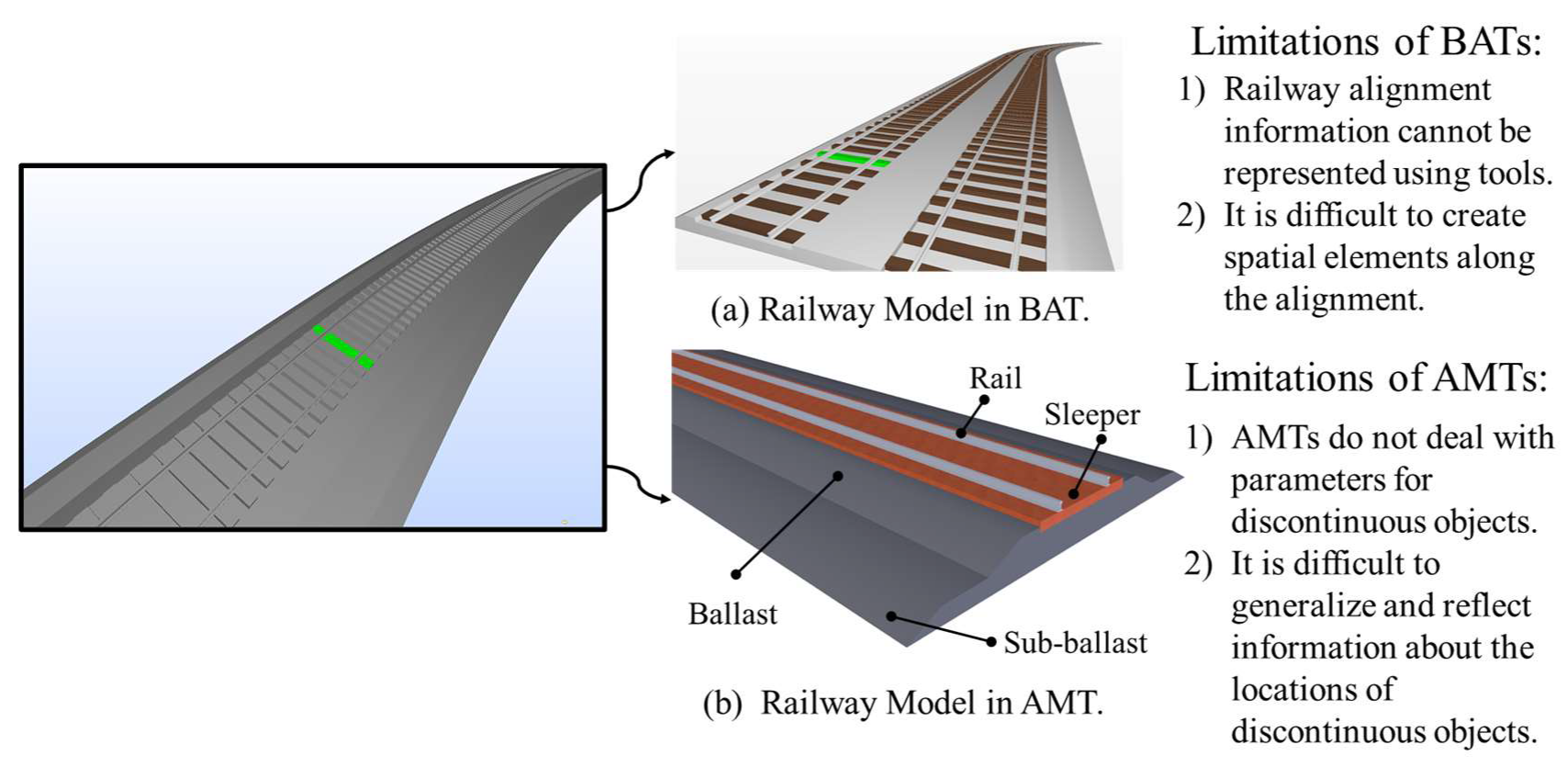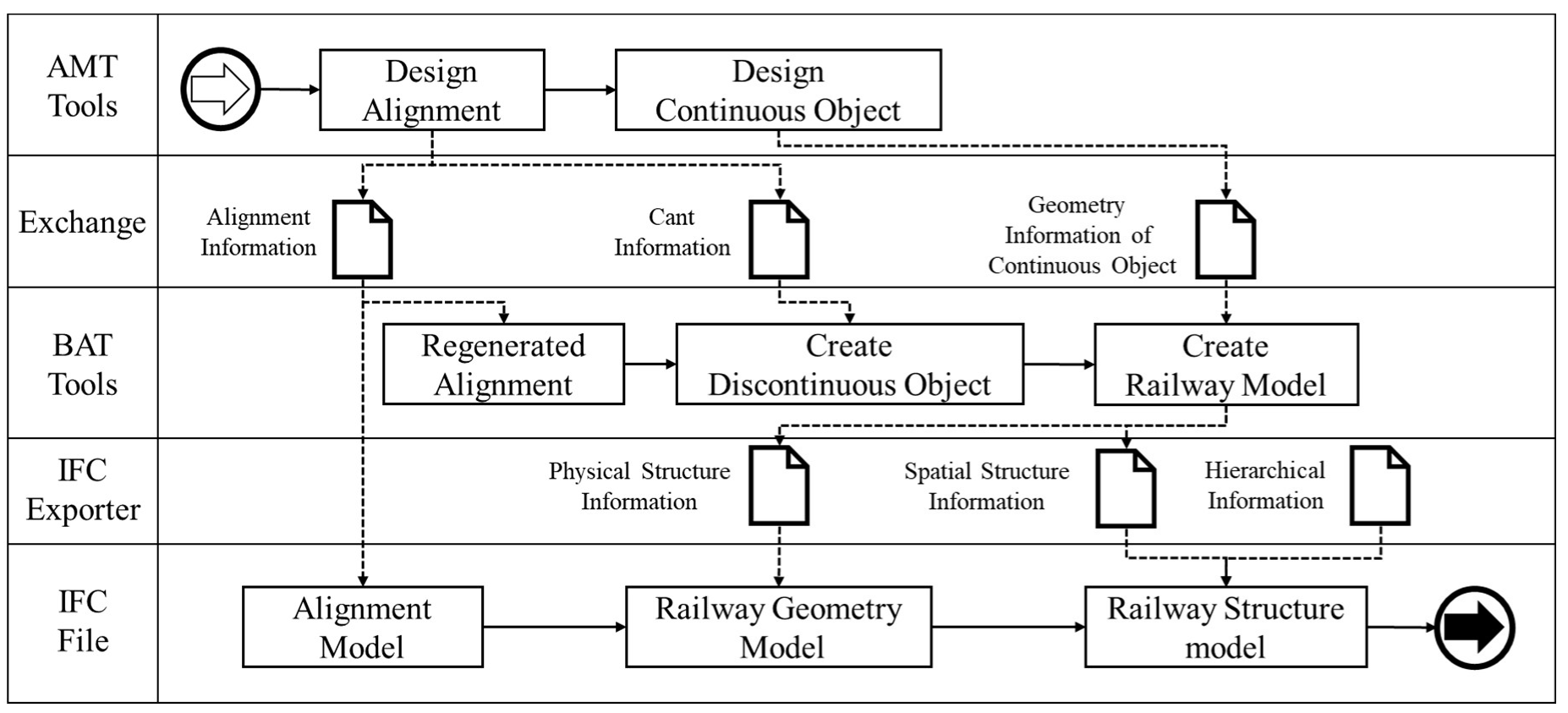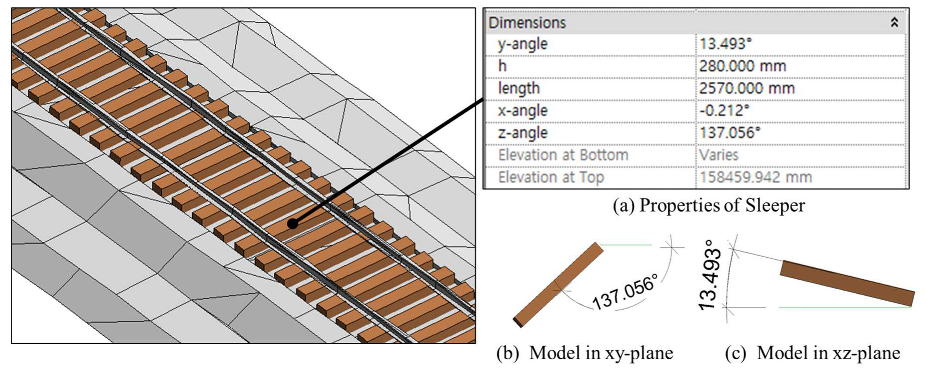Design of Railway Track Model with Three-Dimensional Alignment Based on Extended Industry Foundation Classes
Abstract
:Featured Application
Abstract
1. Introduction
2. Limitations of Railway Infrastructure Information Model Creation Methods
- Railway alignment is designed using horizontal and vertical curves composed of straight lines, curves, and transition curves. BATs predominantly employ straight lines and circular curves but do not provide functions for combining the horizontal and vertical lines. Therefore, railway alignment information cannot be represented using such tools and is also not suitable for representing the shapes of structures that belong to the alignment.
- While buildings are designed based on the floor concept in a direction perpendicular to the ground, railway track structures are arranged using 3D alignment. Therefore, alignment information must be well-represented for railway track structures, and the information must be linked with such structures. However, with BAT software, it is difficult to create an alignment that includes railway alignment information and further link this information with the created structure.
- Railway alignment does not incorporate parameters for discontinuous objects, such as sleepers; instead, it considers them as a part of the continuous alignment. Therefore, the process of extracting parameters to be applied directly to sleepers is complicated.
- Problems regarding arrangement occur for discontinuous objects that follow 3D curves; it is difficult to generalize and reflect information regarding the angle between sleepers and the alignment, which is applied as a design parameter using AMTs. For example, the cant must be calculated at the location of each sleeper because this varies depending on its location in the alignment; however, it is difficult for AMTs to reflect the cant because AMTs cannot accurately represent discontinuous structures.
3. Modeling Methodology for Railway Track Structure Representation
3.1. Information Linkage between Software to Share Alignment Information
3.2. Representation of Discontinuous Railway Track Structures
4. Extended IFC-Based Information Model Creation Method
4.1. IFC Extension for Railway Track Object Representation
4.2. Extended IFC-Based Information Model Creation Method
5. Verification of the Proposed Methodology through the Railway Track Modeling
6. Discussion and Conclusions
Author Contributions
Funding
Conflicts of Interest
References
- Zhou, C.; Wang, W. Highway bridge construction process simulation base on 4D visualization. In Asphalt Material Characterization, Accelerated Testing, and Highway Management: Selected Papers, Proceedings of 2009 GeoHunan International Conference, Changsha, Hunan, China, 3–6 August 2009; ASCE: Reston, VA, USA, 2009; pp. 138–145. [Google Scholar] [CrossRef]
- Kim, H.; Orr, K.; Shen, Z.; Moon, H.; Ju, K.; Choi, W. Highway alignment construction comparison using object-oriented 3D visualization modeling. J. Constr. Eng. Manag. 2014, 140, 05014008. [Google Scholar] [CrossRef]
- Vitásek, S.; Matějka, P. Utilization of BIM for automation of quantity takeoffs and cost estimation in transport infrastructure construction projects in the Czech Republic. In Proceedings of the IOP Conference Series: Materials Science and Engineering, Prague, Czech Republic, 21–22 September 2017; IOP Publishing: Bristol, England, 1874; p. 012110. [Google Scholar] [CrossRef] [Green Version]
- Jones, S.; Laquidara-Carr, D.; Lorenz, A.; Buckley, B.; Barnett, S. The Business Value of BIM for Infrastructure 2017; Dodge Data & Analytics: Bedford, MA, USA, 2017. [Google Scholar]
- Qatar Rail. Qatar Rail Building Information Modelling Guidelines-MCR Overview; Qatar Rail: Doha, Qatar, 2011. [Google Scholar]
- China Railway BIM Alliance. Alliance (CRBIM) (2015) Railway BIM Data Standard Version 1.0; China Railway BIM Alliance: Beijing, China, 2013. [Google Scholar]
- MTR. Hong Kong Metro MTR Sustainability Report 2016; MTR: New Kowloon, Hong Kong, China, 2016. [Google Scholar]
- Froese, T. Future directions for IFC-based interoperability. J. Inf. Technol. Constr. 2003, 8, 231–246. [Google Scholar] [CrossRef]
- Venugopal, M.; Eastman, C.M.; Sacks, R.; Teizer, J. Semantics of model views for information exchanges using the industry foundation class schema. Adv. Eng. Inform. 2012, 26, 411–428. [Google Scholar] [CrossRef]
- Costin, A.; Adibfar, A.; Hu, H.; Chen, S.S. Building Information Modeling (BIM) for transportation infrastructure–literature review, applications, challenges, and recommendations. Automat. Constr. 2018, 94, 257–281. [Google Scholar] [CrossRef]
- Sampaio, A.N.Z. Geometric modeling of box girder deck for integrated bridge graphical system. Automat. Constr. 2003, 12, 55–66. [Google Scholar] [CrossRef]
- Ji, Y.; Borrmann, A.; Obergrieβer, M. Toward the exchange of parametric bridge models using a neutral data format. In Proceedings of the International Workshop on Computing in Civil Engineering, Miami, FL, USA, 19–22 June 2011; ASCE: Reston, VA, USA, 2011; pp. 528–535. [Google Scholar] [CrossRef] [Green Version]
- Amann, J.; Singer, D.; Borrmann, A. Extension of the upcoming IFC alignment standard with cross sections for road design. In Proceedings of the ICCBEI 2015, Tokyo, Japan, 22–24 April 2015; AGCEI: Tokyo, Japan, 2015; pp. 22–24. [Google Scholar]
- Lee, G.; Sack, R.; Eastman, C.M. Specifying parametric building object behavior (BOB) for a building information modeling system. Automat. Constr. 2006, 15, 758–776. [Google Scholar] [CrossRef]
- Neves, J.; Sampaio, Z.; Vilela, M. A Case study of BIM implementation in rail track rehabilitation. Infrastructures 2019, 4, 8. [Google Scholar] [CrossRef] [Green Version]
- Kenley, R.; Harfield, T.; Behnam, A. BIM interoperability limitations: Australian and Malaysian rail projects. In Proceedings of the 4th International Building Control Conference 2016, Kuala Lumpur, Malaysia, 7–8 March 2016; EDP Sciences: Les Ulis, France, 2016; p. 00102. [Google Scholar] [CrossRef] [Green Version]
- Jeong, Y.-S.; Eastman, C.; Sacks, R.; Kaner, I. Benchmark tests for BIM data exchanges of precast concrete. Automat. Constr. 2009, 18, 469–484. [Google Scholar] [CrossRef]
- Nour, M. Performance of different (BIM/IFC) exchange formats within private collaborative workspace for collaborative work. J. Inf. Technol. Constr. 2009, 14, 736–752. [Google Scholar] [CrossRef]
- Venugopal, M.; Eastman, C.M.; Teizer, J. An ontology-based analysis of the industry foundation class schema for building information model exchanges. Adv. Eng. Inform. 2015, 29, 940–957. [Google Scholar] [CrossRef] [Green Version]
- Steuer, H.; Flurl, M.; Donaubauer, A.; Mundani, R.-P.; Kolbe, T.H.; Rank, E. Collaborative planning of inner-city-railway-tracks: A generic description of the geographic context and its dynamic integration in a collaborative multi-scale geometry modelling environment. Adv. Eng. Inform. 2014, 28, 261–271. [Google Scholar] [CrossRef]
- ISO-TC59/SC13. ISO 16739-1:2018 Industry Foundation Classes (IFC) for Data Sharing in the Construction and Facility Management Industries—Part 1: Data Schema; ISO: Geneva, Switzerland, 2014. [Google Scholar] [CrossRef]
- Yabuki, N.; Lebegue, E.; Gual, J.; Shitani, T.; Zhantao, L. International collaboration for developing the bridge product model IFC-Bridge. In Proceedings of the Joint International Conference on Computing and Decision Making in Civil and Building Engineering, Montreal, QC, Canada, 14–16 June 2006; EG-ICE: Berlin, Germany, 2006. [Google Scholar] [CrossRef] [Green Version]
- Amann, J.; Flurl, M.; Jubierre, J.; Borrmann, A. An approach to describe arbitrary transition curves in an IFC-based alignment product data model. In Proceedings of the 2014 International Conference on Computing in Civil and Building Engineering, Orlando, FL, USA, 23–25 June 2014; ASCE: Reston, VA, USA, 2014; pp. 933–941. [Google Scholar] [CrossRef] [Green Version]
- Chipman, T.; Costin, A.; Eastman, C.; Grant, R.; Liebich, T.; Smith, D.; Yang, D. Bridge Information Modeling Standardization–Report Introduction; National Institute of Building Sciences: Washington, DC, USA, 2016. [Google Scholar]
- Park, S.I.; Park, J.; Kim, B.-G.; Lee, S.-H. Improving Applicability for Information Model of an IFC-Based Steel Bridge in the Design Phase Using Functional Meanings of Bridge Components. Appl. Sci. 2018, 8, 2531. [Google Scholar] [CrossRef] [Green Version]
- buildingSMART. IFC Overview Summary, buildingSMART International. Available online: https://standards.buildingsmart.org/IFC/DEV/IFC4_2/FINAL/HTML/ (accessed on 14 May 2020).
- Lee, S.-H.; Park, S.I.; Kwon, T.H.; Seo, K.-W. Civil infrastructure information modeling method based on extended IFC entities using BIM authoring software. J. Comput. Struct. Eng. Inst. Korea 2017, 30, 77–86. [Google Scholar] [CrossRef]
- Gao, G.; Liu, Y.-S.; Wu, J.-X.; Gu, M.; Yang, X.-K.; Li, H.-L. IFC Railway: A Semantic and Geometric Modeling Approach for Railways based on IFC. In Proceedings of the 16th International Conference on Computing in Civil and Building Engineering, Osaka, Japan, 6–8 July 2016; ISCCBE: Osaka, Japan, 2016; pp. 1188–1195. [Google Scholar]
- Huang, S.-F.; Chen, C.-S.; Dzeng, R.-J. Design of track alignment using building information modeling. J. Transport. Eng. 2011, 137, 823–830. [Google Scholar] [CrossRef]
- Autodesk. User’s Guide, Autodesk; Autodesk: San Rafael, CA, USA, 1982. [Google Scholar]
- Kwon, T.H.; Park, S.I.; Shin, M.H.; Lee, S.-H. Information Modeling of Railway Track using Information Iinkage of Railway Alignment and Alignment-based Objects. J. Comput. Struct. Eng. Inst. Korea 2017, 30, 507–514. [Google Scholar] [CrossRef]
- JEZYK, M. The Dynamo Primer; Autodesk: San Rafael, CA, USA, 1982. [Google Scholar]
- Lee, S.-H.; Park, S.I.; Park, J. Development of an IFC-based data schema for the design information representation of the NATM tunnel. KSCE J. Civ. Eng. 2016, 20, 2112–2123. [Google Scholar] [CrossRef]
- Korea Rail Network Authority. Procedures of Project Management for Railway; Korea Rail Network Authority: Daejeon, Korea, 1963; Volume 34. [Google Scholar]
- Crawford, M.J.; Cann, J.; O’Leary, R. Uniclass: Unified Classification for the Construction Industry; RIBA: London, UK, 1997. [Google Scholar]
- OmniClass, C. Introduction and User’s Guide; The Construction Specification Institute: Alexandria, Egypt, 2006. [Google Scholar]
- STEP Tools. ST-Developer online Manuals; STEP Tools: New York, NY, USA, 1991–2007. [Google Scholar]
- Autodesk. Autodesk Civil 3D 2020. Available online: https://help.autodesk.com/view/CIV3D/2020/ENU/ (accessed on 14 May 2020).
- Autodesk. Autodesk Revit 2020. Available online: https://help.autodesk.com/view/RVT/2020/ENU/ (accessed on 14 May 2020).













| Entity | Attribute | Type | Enumeration |
|---|---|---|---|
| IfcTrackRail | Predefined Type | IfcTrackRail TypeEnum | MAINRAIL, GUARDRAIL, LEADRAIL, TONGUERAIL, CROSSING, USERDEFINED, NOTDEFINED |
| IfcTrack Sleeper | Predefined Type | IfcTrackSleeper TypeEnum | WOODENSLEEPER, CONSLEEPER, USERDEFINED, NOTDEFINED |
| Function Type | IfcTrackSleeperFunction TypeEnum | MONOBLOCK, BIBLOCK, USERDEFINED, NOTDEFINED | |
| IfcTrack Fastening | Predefined Type | IfcTrackFastening TypeEnum | ELASTICRAILFASTENING, RIGIDRAILFASTENING, USERDEFINED, NOTDEFINED |
| Function Type | IfcTrackFasteningStructure TypeEnum | SEPARATEDRAILFASTENING, SEMISEPARATEDRAILFASTENING, NONSEPARATEDRAILFASTENING, USERDEFINED, NOTDEFINED | |
| IfcTrack Ballast | Predefined Type | IfcTrackBallast TypeEnum | CRUSHEDSTONEBALLAST, PEBBLEBALLAST, SANDBALLAST, SLAGBALLAST, CONBALLAST, USERDEFINED, NOTDEFINED |
| IfcTrack Turnout | Predefined Type | IfcTrackTurnout TypeEnum | LEFTHANDTURNOUT, RIGHTHANDTURNOUT, SYMMETRICALTURNOUT, SLIPTOURNOUT, SCISSORSCROSSING, DIAMONDCROSSING, COMBINATIONOFSLIPTURNOUTANDSCISSORSCROSSING, USERDEFINED, NOTDEFINED |
| IfcTrack (space) | Predefined Type | IfcTrack TypeEnum | PARTIAL, SINGLE, COMPLEX, USERDEFINED, NOTDEFINED |
| IfcTrackPart (space) | Predefined Type | IfcTrackPart TypeEnum | MAINTRACK, STATIONTRACK, BRIDGETRACK, TUNNELTRACK, USERDEFINED, NOTDEFINED |
| Track Gauge | IfcLengthMeasure | ||
| Slack | IfcLengthMeasure |
| Category | Code | Object | Extended IfcEntity |
|---|---|---|---|
| Common | BA000 | Common | IfcCivilElementProxy |
| Rail | BA101 | Rail | IfcTrackRail |
| Sleeper | BA201 | Concrete sleeper | IfcTrackSleeper |
| BA202 | Wood sleeper | IfcTrackSleeper | |
| Ballast | BA301 | Gravel ballast | IfcTrackBallast |
| BA302 | Concrete ballast | IfcTrackBallast | |
| Facilities | BA400 | Common | IfcCivilElementProxy |
| BA401 | Fish plate | IfcTrackFastening | |
| BA402 | Expansion joint | IfcTrackFastening | |
| BA403 | Insulated rail | IfcTrackRail | |
| BA404 | Compromised rail | IfcTrackRail | |
| Turnout | BC101 | Turnout | IfcTrackTurnout |
| Object | IFC Model Data |
|---|---|
| Sleeper- #2195949 | ⋯ |
| #10=IFCTRACK(‘g12xD33Df0OSVcfMeX1IPA’,$,‘Track_9-11km’,‘’,‘’,$,$,‘’,$,.COMPLEX.); | |
| #11=IFCRELCONTAINEDINSPATIALSTRUCTURE(‘8UBCh9ZZt06yQPuB+G0IRg’,#1419392,‘Station1’,$,(#566038,#566039,#1419393,#1419394,#2195945,⋯,#2195949, #2785901,⋯),#2199347); | |
| #870446=IFCPRODUCTDEFINITIONSHAPE($,$,(#873860)); | |
| #2172039=IFCRELAGGREGATES(‘lEfakPELQkqvscvYEO+o/A’,#1419392,‘Site’,$,#2172046,(#10)); | |
| #2172040=IFCRELAGGREGATES(‘l5ps4odfwqOz2oxFRsAuzg’,#1419392,‘Track_9-11km’,$,#10,(#2199347,#2199348,#2199349)); | |
| #2172046=IFCSITE(‘LF48Xx6oO0+esS//+ImT0Q’,#1419392,‘Site’,‘’,‘’,#566044,$,‘’,$,(42,21,31,181945),(−71,−3,−24,−263305),0.0,‘’,$); | |
| #2199347=IFCTRACKPART(‘WSunyN1gV0mnF8dyoJ6mVg’,$,‘Station1’,‘’,‘’,$,$,‘’,$,$,1500,0.0); | |
| #2195949=IFCTRACKSLEEPER(‘Rsk2ej62mUyH5bA/Pv1eRg’,#1419392,‘sleeper’,‘’,‘’,#566044,#870446,‘’,$,$); | |
| #542197=IFCRELDEFINESBYPROPERTIES(‘6OTRuJsNlUG31kjlq50Tmw’,#1419392,$,$,(#2195949),#2172105); | |
| #2172105=IFCPROPERTYSET(‘nQdRHi05DU+YTmXxLT0ryA’,#1419392,‘Identity Data (Type)’,$,(2199434,#2199435,#2199436,#2199437,#2199438,#2199439,#2199440,#2199441)); | |
| #2199441=IFCPROPERTYSINGLEVALUE(‘Type’,$,IFCTEXT(‘Wood’),$); | |
| #2785901=IFCALIGNMENT(‘WGzzDEO8XUOCxMz4t49qkQ’,$,‘Alignment - (9)’,‘’,‘’,$,$,$,#2785910,.NOTDEFINED.) | |
| #2785910=IFCALIGNMENTCURVE(#2785954,#2786105, $) | |
| ⋯ |
© 2020 by the authors. Licensee MDPI, Basel, Switzerland. This article is an open access article distributed under the terms and conditions of the Creative Commons Attribution (CC BY) license (http://creativecommons.org/licenses/by/4.0/).
Share and Cite
Kwon, T.H.; Park, S.I.; Jang, Y.-H.; Lee, S.-H. Design of Railway Track Model with Three-Dimensional Alignment Based on Extended Industry Foundation Classes. Appl. Sci. 2020, 10, 3649. https://doi.org/10.3390/app10103649
Kwon TH, Park SI, Jang Y-H, Lee S-H. Design of Railway Track Model with Three-Dimensional Alignment Based on Extended Industry Foundation Classes. Applied Sciences. 2020; 10(10):3649. https://doi.org/10.3390/app10103649
Chicago/Turabian StyleKwon, Tae Ho, Sang I. Park, Young-Hoon Jang, and Sang-Ho Lee. 2020. "Design of Railway Track Model with Three-Dimensional Alignment Based on Extended Industry Foundation Classes" Applied Sciences 10, no. 10: 3649. https://doi.org/10.3390/app10103649
APA StyleKwon, T. H., Park, S. I., Jang, Y.-H., & Lee, S.-H. (2020). Design of Railway Track Model with Three-Dimensional Alignment Based on Extended Industry Foundation Classes. Applied Sciences, 10(10), 3649. https://doi.org/10.3390/app10103649





